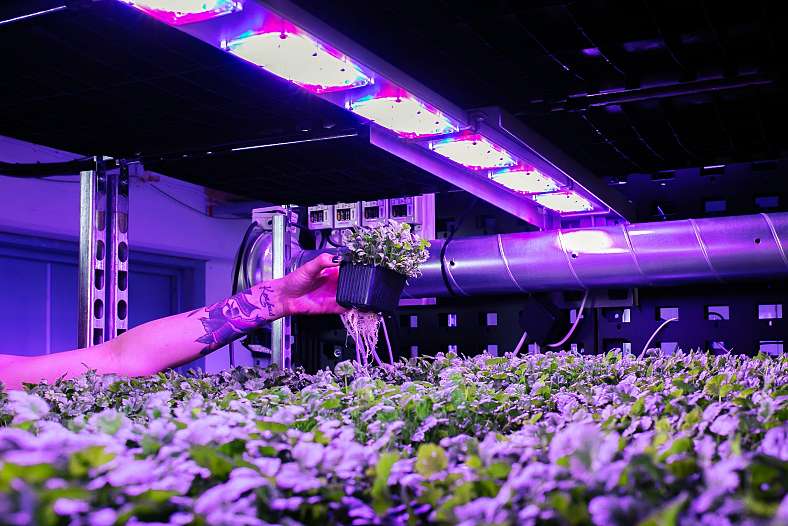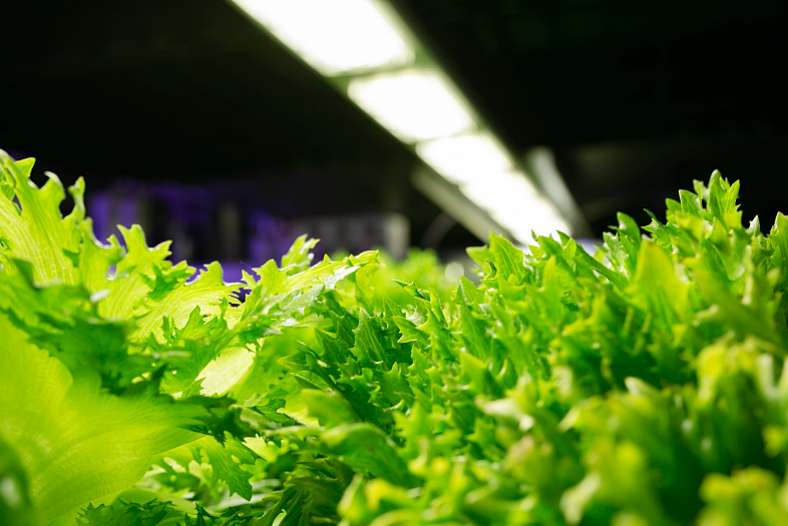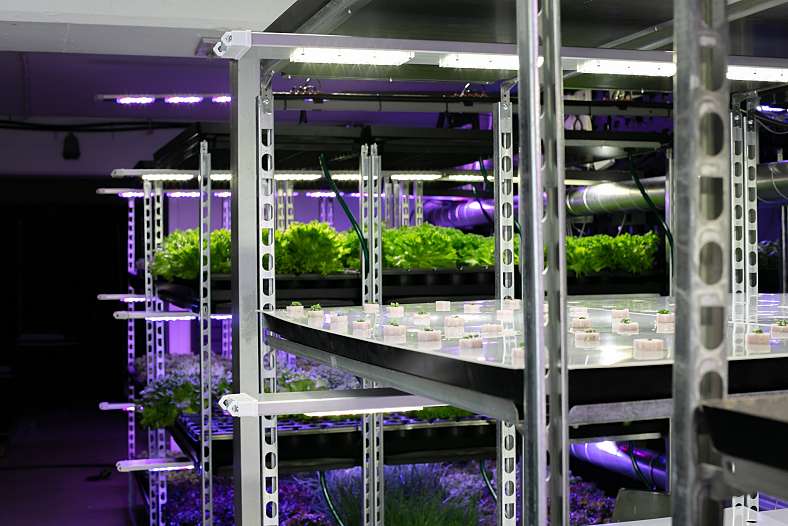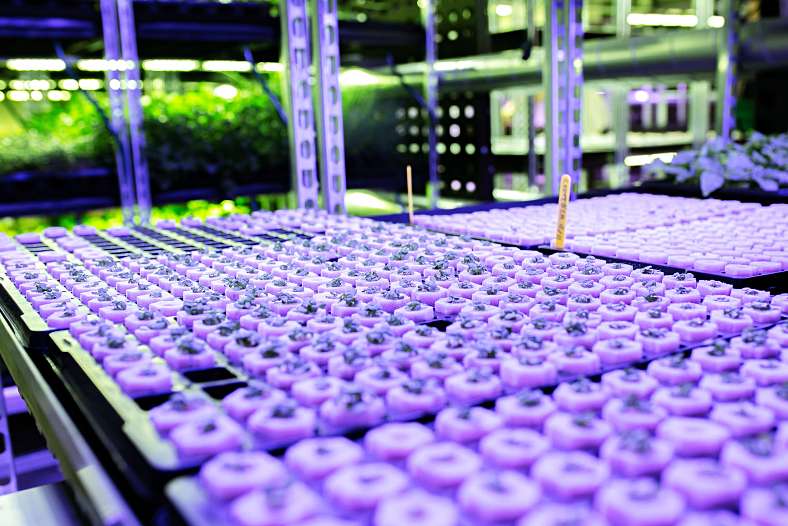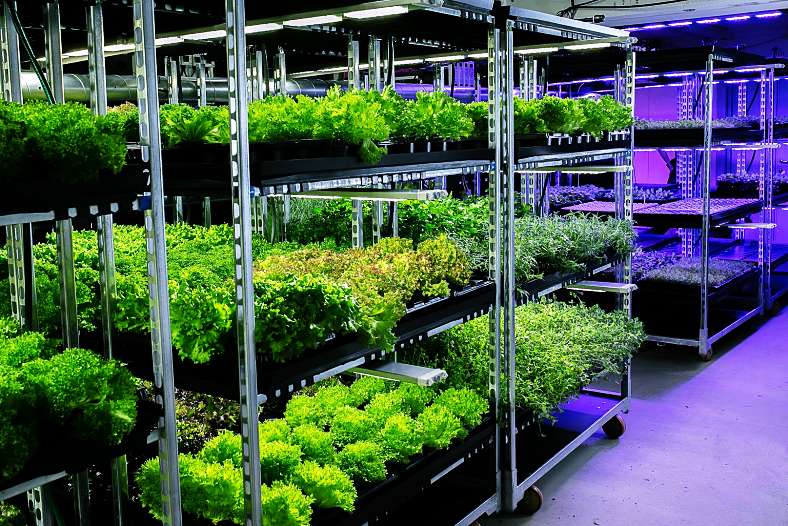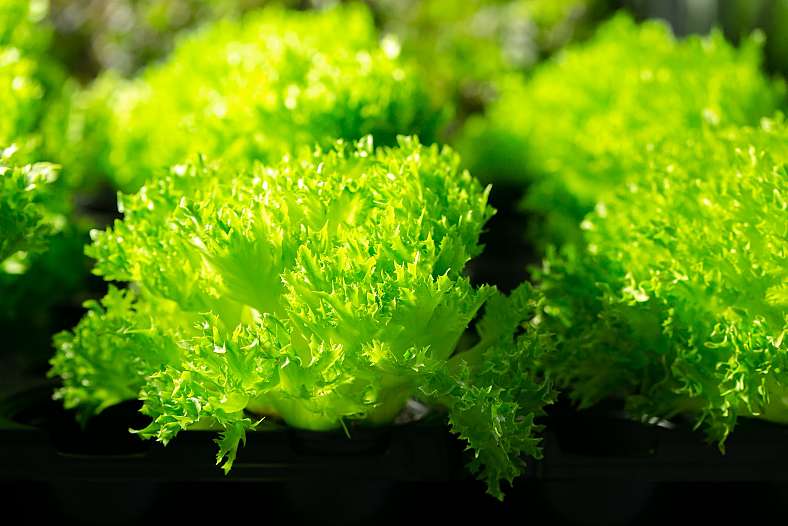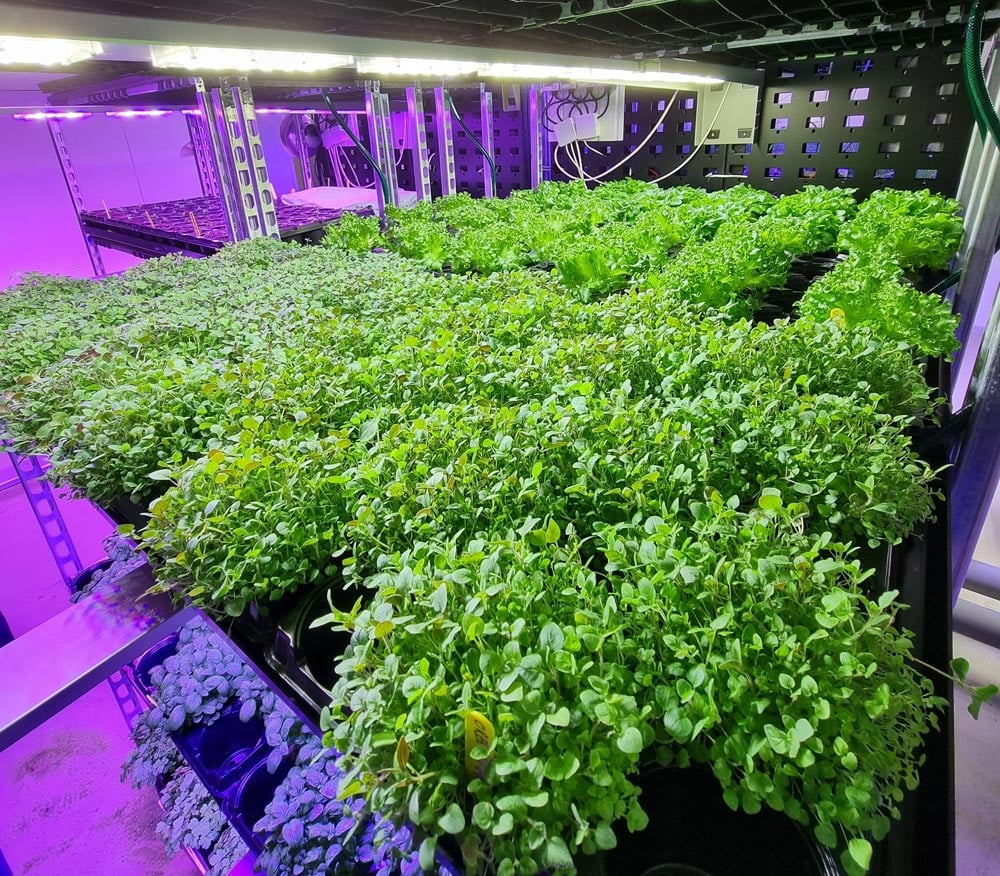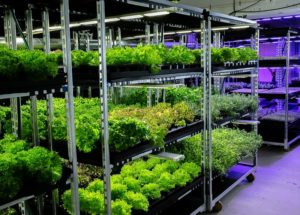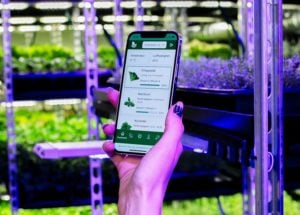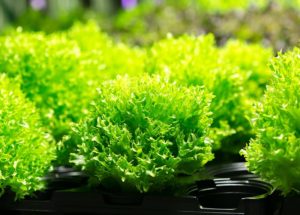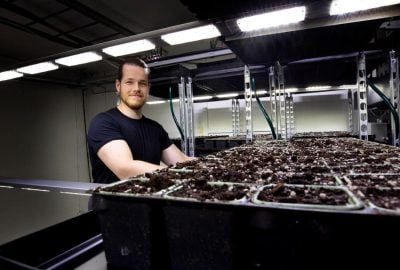What plants can you grow on a vertical farm? Leafy greens and herbs used to be the only vertical farm crops that ensured profit, but times have changed. Indoor farmers are no longer held back by a limited selection of vertical farming plants. And soon, more plant types will be available. Here is a list of plants that grow vertically with ease:
Relevant article: Vertical farming – From concept to profit
In principle, all kinds of plants can grow vertically. So, why do vertical farms tend to focus on the same limited plant selection? Well, in most cases, it’s a matter of profitability. Usually, the earning potential depends on how long your crops can be stored and the quantity that must be grown to avoid losses.
Salads, herbs, and microgreens have been relatively safe plants to ensure vertical farming profitability. It is pretty straightforward to stabilize the production of these plants, and they grow quickly. In addition, there is a massive demand for fresh salads, herbs, and microgreens, which gives vertical farms an edge in the market.
Vertical farm plants to choose and avoid
A well-planned vertical farm is located close to its consumers. This allows them to deliver fresh plants on short notice. It makes vertical farms very competitive in the fresh produce market. On the other hand, they don’t stand as strong when it comes to plants that can be stored over longer periods.
Potatoes, for instance, can grow vertically, but they can also be stored for quite some time without going bad. This gives traditional farms an edge since they can produce and deliver copious amounts of potatoes. This way, traditional farms can lower their prices, making it hard for vertical farms to compete.
That said, the selection of plants that can grow vertically expands by the minute. New plant recipes are constantly developed all around the globe, many of which promise immense earning potential.
We’ll get back to the latest trends and developments of vertical farm plants in a little bit, but let’s first look at the safe bets. Here are the plants that vertical farms already turn huge profits from.
The most profitable vertical farming plants right now
The late 90s saw the dawn of modern vertical farming. From a technical aspect, indoor farming has improved a lot since then. In practice, however, implementing new technology and methods has been time-consuming.
While plant scientists worked on making the technology more applicable, farmers perfected the growth of plants that turned a profit here and now.
Relevant article: What does vertical farming mean to investors?
1. Salads
Salads are undoubtedly the most popular vertical farming plants there are. Anything from superfoods like spinach and green kale to everyday dinner foods like crispy salads and baby leaves are grown with great success.
There are a couple of reasons why salads are the most popular vertical farming crops. For one, the demand for fresh salads is never-ending. Secondly, salad plant recipes have been developed for more than twenty years. So far, salads have proven to be a relatively safe bet when it comes to vertical farming plants.
A possible challenge for indoor plant farmers is market saturation. Vertical farming is gaining traction worldwide. At some point, salad producers will probably saturate the market. Those who already have established their brand will stand firm. But it will be increasingly harder for vertical farm startups to base their business on salad production.
2. Herbs
Herbs are the second most popular vertical farming crop on the market today. Just like salads, herbs are also high in demand. The downside is that the competition is looking to get fierce when vertical farms spread to all corners of the earth.
3. Microgreens
The demand for fresh microgreens is comparable to salads and herbs. However, microgreens have a much larger profit potential. The reason for this is that microgreens’ growth cycle is much shorter. You can grow these vertical farming crops 36 times a year if you do it right.
Another difference between microgreens and salads/herbs is that supermarkets are not necessarily your best customers. Instead, you might be catering to restaurants, specialty shops, markets, or health stores. The business potential in microgreens cultivation is vast, but it depends on your networking abilities.
4. Tomatoes
Vertical farm tomatoes have yet to spread all over the globe, but some countries have already turned it into big business. Once the plant recipes for tomatoes are adequately perfected, they will probably become a staple in the vertical farming industry. Be aware that tomatoes are fragile and that their plants reach high.
5. Cucumbers
Cucumber is another vertical farming plant that has yet to spread worldwide. Some vertical farms have grown cucumbers very successfully, however. It’s a well-suited plant for vertical farming since it’s relatively lightweight for its size. Therefore, it is likely that cucumbers will soon become a more widespread vertical farming crop.

Vertical farm plants on the rise
Well-developed plant recipes and automation has made salads, herbs, and microgreens the most widespread vertical farming crops. These days, many new and exciting plants are entering the industry. Plant scientists have already developed loads of plant recipes that are just waiting to be perfected by vertical farming enthusiasts.
The indoor plant industry will be much more competitive once these new plants get a foothold in the vertical farming community. As the vertical farming plant selection expands, so does the influence of indoor farmers and their brands.
Relevant article: Vertical farming – The future of food production (coming soon)
1. Mushrooms
Infarm is the biggest vertical farming company in Europe. They have promised to engage in large-scale production of both mushrooms and strawberries by 2022. In other words, mushrooms and strawberries will soon become standard vertical farming plants.
Read more about Infarm in our article about vertical farming’s biggest challenges.
The market for healthier and tastier mushrooms and strawberries is largely untapped in Europe. Many traditional farms grow them on a large scale. On vertical farms, however, mushrooms and strawberries are not so common. The question is, who will capture this market segment first?
2. Strawberries
The prospect of vertically grown strawberries is especially exciting in our native Norway. The strawberry season is very short in Norway, which is why Norwegians are crazy about these tasty treats. And we take great pride in our locally grown strawberries.
In Norway’s case, vertically grown strawberries offer a huge business opportunity. What if we could sell locally grown strawberries year-round? Right now, there is a huge gap in the market. The vertical farm that steps up and perfects the plant recipe for Norwegian strawberries will probably be an overnight sensation.
3. Beans
Green beans and French beans (common beans or pole beans) grow exceptionally well in vertical farming environments. These bean types grow vertically in nature, making them perfect vertical farming plants.
4. Peas
Peas are another contender for the next craze in vertical farming. They grow very well in hydroponic growth systems. Typically, their growth cycle is about eight weeks, which means you get six growth cycles per year.
Considering that peas can be marketed as a superfood with very high nutritional value, the earning potential for this vertical farm plant is massive.
5. Water lentils
Water lentils are a vertical farming niche that some companies already make excellent profits from.
Canadian company Pontus Water Lentils started in this niche. They have since turned into a developer of indoor aquaponic plant factories. Check out this interview with Pontus Water Lentils and get inspiration for your own vertical farming journey.
6. Bell peppers
Plant recipes for bell peppers are currently under development. So far, bell peppers have been pre-grown on vertical farms with great success, but the prospect of growing bell pepper to full size is much more exciting.
The earning potential is enormous, especially since vertical farm plants can be perfected beyond the dodgy bell peppers you’ll find in many supermarkets today. Pre-growth is also a very promising field within vertical farming, which we’ll get back to in a minute.
7. Black pepper
Like the beans mentioned above, also black pepper grows vertical in nature. It has proven to be an excellent vertical farming plant, though it thrives best in so-called growth towers.
These towers might be more costly than average vertical farm systems because they are not as common. That said, because of lighting, irrigation, and ventilation accuracy, black pepper grows more efficiently in vertical farms than anywhere else on the planet.
8. Flowers
Philips has a team that develops vertical farming plant recipes for flowers. The Philips team discovered that all flowers grow well on vertical farms. So, they decided to create a bunch of recipes to turn this concept into a viable business. Soon, we will probably see vertical plant factories dedicated to flower production.

Vertical farming crops with massive profit potential
There are some kinks to iron out, but the latest developments in the vertical farming industry come with massive earning potential. First and foremost, farming methods and sales networks need to be developed.
With that said, the business potential in growing medicines, extracts, and pre-growth is too significant to overlook. If you are planning to or currently engage in a vertical farming startup, you need to consider these options.
Relevant Article: Why is CEA growing so fast? (Controlled-Environment Agriculture)
1. Pre-growth
Pre-growth is a simple yet exciting prospect. The idea is to do the first phase of plant growth indoors. Once the vertical farm plants have grown to a certain point, they are moved to other farming environments.
Many plants thrive when pre-grown like this. Vertical farms offer a safe and comfortable environment. This results in strong sprouts with a much better chance of reaching full growth potential in greenhouses or outdoor environments.
Pre-growth is exciting because it promotes cooperation between different types of farms. Not only that, but it also allows vertical farms to grow a much wider range of plants.
In many ways, pre-growth is a bridge-builder and a door-opener for vertical farms. It can help you build networks and get a foothold in your local farming community.
2. Medicines
Indoor cultivation is perfect for medicinal plants. The closed environment is easier to sanitize and keep free from bacteria and insects.
It goes without saying that the earning potential is huge, but it also comes with some serious challenges. Regulations and sanctions can be difficult to handle, and sales networks can be hard to establish. If you succeed, though, the gains are limitless.
3. Plant extracts
Vertical farming’s closed environment is also ideally suited for plant extract cultivation. The earning potential is massive, and the regulations are not as strict as for medicinal plants. If you can develop good channels for sales and distribution, plant extract growth might be very lucrative.
Conclusion
Vertical farming is a future force to reckon with in the global food industry. So far, consumers have yet to realize how much better vertical farm plants are than other plants. This will change soon enough as vertical farming continues to expand its horizon. New doors will open for the vertical farming industry when the consumers get on board.
It’s only a matter of time before the vertical farm plant selection expands beyond salads, herbs, and microgreens. Vertical plant factories are already upgrading their plant selection, and soon, every vertical farm on the planet will follow in their footsteps.
The odds are that you’ll find vertically grown strawberries, mushrooms, beans, and lentils within the year in most supermarkets. This is good news for both the industry and the consumers. Since there are no seasons in vertical farming, we can soon enjoy our favorite plants year-round, and they will always be fresh and delicious.
Relevant article: Why invest in vertical farming?
Resources
GardeningHeavn: Top 11 Best Plants For Hydroponics
GrowZone: How to grow tomatoes indoors with Full Spectrum LED grow lights
HortiGrowlight.com: ProefCentrum Hoogstraten – Paprika under LED grow lights
Michigan State University: Crops Suitable for Vertical Farming
NASA: NASA Research Launches a New Generation of Indoor Farming
Philips: Follow us on a new journey combining floriculture and vertical farming
Saving Earth Magazine: Reinventing farming: Pontus water lentils of Vancouver
Urban Kisaan: Building an effective indoor farming technique at home
Vertical Farming: Food Crops
WhyFarmIt: Best Plants To Grow Hydroponically: Proven Veggies, Fruits, Herbs


